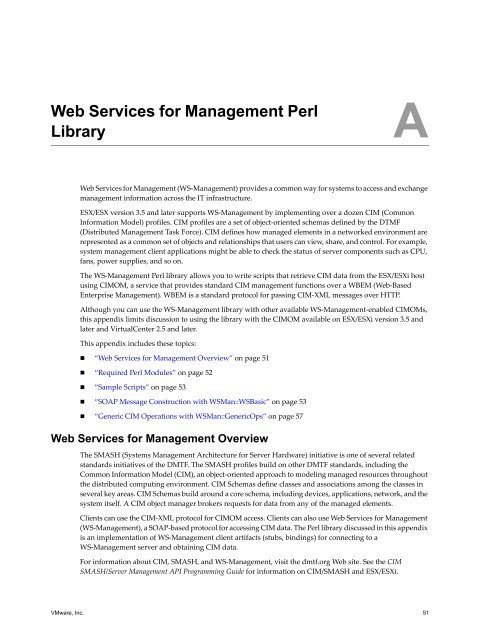vSphere SDK for Perl Programming Guide - Documentation - VMware
vSphere SDK for Perl Programming Guide - Documentation - VMware
vSphere SDK for Perl Programming Guide - Documentation - VMware
Create successful ePaper yourself
Turn your PDF publications into a flip-book with our unique Google optimized e-Paper software.
A<br />
Web Services <strong>for</strong> Management <strong>Perl</strong><br />
A<br />
Library<br />
Web Services <strong>for</strong> Management (WS‐Management) provides a common way <strong>for</strong> systems to access and exchange<br />
management in<strong>for</strong>mation across the IT infrastructure.<br />
ESX/ESX version 3.5 and later supports WS‐Management by implementing over a dozen CIM (Common<br />
In<strong>for</strong>mation Model) profiles. CIM profiles are a set of object‐oriented schemas defined by the DTMF<br />
(Distributed Management Task Force). CIM defines how managed elements in a networked environment are<br />
represented as a common set of objects and relationships that users can view, share, and control. For example,<br />
system management client applications might be able to check the status of server components such as CPU,<br />
fans, power supplies, and so on.<br />
The WS‐Management <strong>Perl</strong> library allows you to write scripts that retrieve CIM data from the ESX/ESXi host<br />
using CIMOM, a service that provides standard CIM management functions over a WBEM (Web‐Based<br />
Enterprise Management). WBEM is a standard protocol <strong>for</strong> passing CIM‐XML messages over HTTP.<br />
Although you can use the WS‐Management library with other available WS‐Management‐enabled CIMOMs,<br />
this appendix limits discussion to using the library with the CIMOM available on ESX/ESXi version 3.5 and<br />
later and VirtualCenter 2.5 and later.<br />
This appendix includes these topics:<br />
“Web Services <strong>for</strong> Management Overview” on page 51<br />
“Required <strong>Perl</strong> Modules” on page 52<br />
“Sample Scripts” on page 53<br />
“SOAP Message Construction with WSMan::WSBasic” on page 53<br />
“Generic CIM Operations with WSMan::GenericOps” on page 57<br />
Web Services <strong>for</strong> Management Overview<br />
The SMASH (Systems Management Architecture <strong>for</strong> Server Hardware) initiative is one of several related<br />
standards initiatives of the DMTF. The SMASH profiles build on other DMTF standards, including the<br />
Common In<strong>for</strong>mation Model (CIM), an object‐oriented approach to modeling managed resources throughout<br />
the distributed computing environment. CIM Schemas define classes and associations among the classes in<br />
several key areas. CIM Schemas build around a core schema, including devices, applications, network, and the<br />
system itself. A CIM object manager brokers requests <strong>for</strong> data from any of the managed elements.<br />
Clients can use the CIM‐XML protocol <strong>for</strong> CIMOM access. Clients can also use Web Services <strong>for</strong> Management<br />
(WS‐Management), a SOAP‐based protocol <strong>for</strong> accessing CIM data. The <strong>Perl</strong> library discussed in this appendix<br />
is an implementation of WS‐Management client artifacts (stubs, bindings) <strong>for</strong> connecting to a<br />
WS‐Management server and obtaining CIM data.<br />
For in<strong>for</strong>mation about CIM, SMASH, and WS‐Management, visit the dmtf.org Web site. See the CIM<br />
SMASH/Server Management API <strong>Programming</strong> <strong>Guide</strong> <strong>for</strong> in<strong>for</strong>mation on CIM/SMASH and ESX/ESXi.<br />
<strong>VMware</strong>, Inc. 51
















